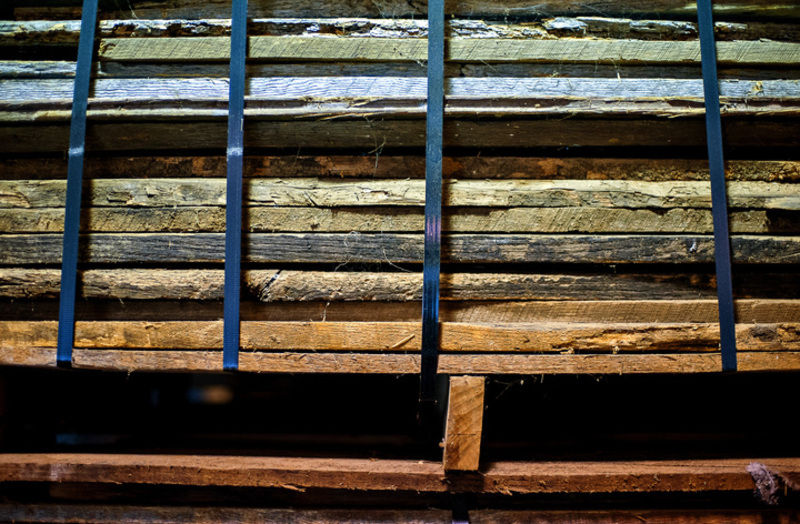Preserving heritage: Furniture-makers reuse wood from demolished barns
Published 7:00 am Saturday, February 13, 2016

- Barn wood is stacked at Southern Heritage Wood Artisans in Horse Cave. (Miranda Pederson/photo@bgdailynews.com)
HORSE CAVE — With old wooden barns disappearing rapidly across the state, a furniture company is dedicated to making sure the material lives on after they’re torn down.
Southern Heritage Wood Artisans, founded in 2014, takes wood from old barns and outbuildings from Kentucky and turns it into furniture.
Nowadays, most people don’t need wooden barns, opting to use cheaper materials instead, meaning that many wooden outbuildings get neglected, co-owner Van Wethington said.
“Eventually, all these old barns will be gone and we just hate to see them … being destroyed,” he said.
The smell of sawdust lingers about Southern Heritage’s facility, a large warehouse-like building, where stacks of lumber pieces, many of which are 100 or more years old, line one of the walls. Wethington spends roughly half of his time at work here, drying wood in the massive, box-like kiln, sawing the wood and making it into furniture.
A line of mostly-completed end tables and coffee tables stands on a long table, waiting for their surfaces to be attached.
“We don’t call it mass production but we don’t build one piece at a time,” Wethington said. “We want to make heirloom pieces that can be handed down for generations.”
The woodworkers at Southern Heritage often make three of a piece at a time, he said, adding that it takes roughly a week to make three dining room tables, he said.
Wethington said most of their business so far has come from word of mouth, from trade shows and traffic on their website, southernheritagewoodartisans.com.
Including him and co-owner Ron Coomes, Southern Heritage has five employees, Wethington said.
Brien Ross, a master woodworker the company hired three weeks ago, has 40 years of wood working experience.
“They were looking for a master craftsman to come in and work with them, give them a little more expertise,” he said.
Before he arrived at Southern Heritage, the company had good designs but needed help with some of the finer details, he said.
“There’s proper ways to make furniture and there’s not proper ways,” Ross said. “There’s a difference between just some Joe Blow making furniture and professionals making furniture and they want to make sure what they put out’s professional quality.”
Though he has experience with woodworking, having worked in construction for half his life, Wethington has still had to learn how to use some of the facility’s new machines and how to put furniture together.
Southern Heritage doesn’t spend any time scouting for lumber, relying instead on the people who tear these barns down to offer the wood to them, Wethington said.
“We just have people bring the wood to us and if it’s our quality, then we’ll purchase it from them,” he said. “They come to us. They know who we are.”
After decades of exposure to the elements, not all of these barns offer up usable lumber. Despite this, there’s been no shortage of quality wood for Southern Heritage to use.
Whenever anyone tears a barn down, Wethington always asks that they take a picture of it beforehand, he said.
“When we ship a product or sell a product, we send a picture of the barn with the product and it also has the latitude and longitude of where the barn was, branded on to the piece of furniture someplace,” Wethington said.
Kentucky once had more old barns per square mile than any other state, according to Craig Potts, executive director of the Kentucky Heritage Council, but many of these barns and other wooden outbuildings have fallen into disrepair or have been demolished.
Modernizations in farming practices have made many old barns unnecessary, he said.
“At the end of the day, outbuildings need jobs,” he said.
The demand for furniture, siding and flooring made from wood taken from demolished old barns is largely due to the fact that “old growth” lumber is otherwise unavailable in Kentucky, Potts said.
Old growth forests are natural forests that have been growing for around 120 years or more without facing severe disturbances like fires or logging, though definitions vary, according to a Minnesota Department of Resources Web page.
Old growth trees have more time to mature than most, which increases the quality of the wood, Potts said.
“Old growth wood is hard as rock,” he said.
All old growth forests in Kentucky are protected, he said, making old growth wood hard to come by. “I think there is definitely a market for materials you can’t get anymore,” he said.
Right now, there are numerous companies across the country dedicated to recycling wood from old barns, but most of them use it for flooring or siding, according to Wethington, though he said he didn’t know of any similar furniture manufacturers in the area.
“It’s gotten really popular because eventually all this wood’s going to be gone,” he said.
— Follow reporter Jackson French on Twitter at twitter.com/Jackson_French or visit bgdailynews.com.





